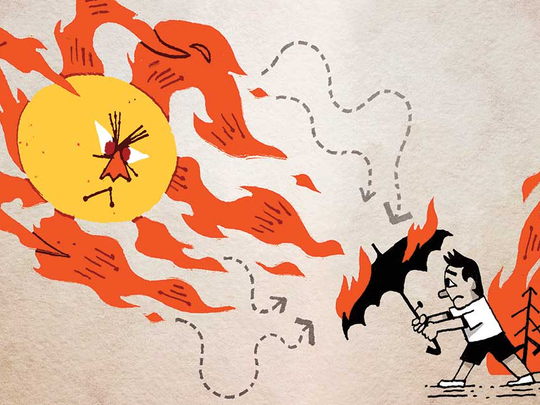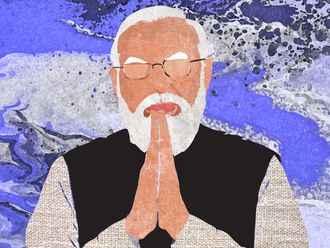
Europe and several parts of the world have been gripped by a heatwave. Temperatures in Portugal have reached 47C and might break the 48.4C record; a weather station in Algeria at the edge of the Sahara desert last week recorded 51.3C, the highest reliable temperature ever recorded in Africa; and deaths have occurred, though for now the numbers are small.
We speak of ‘heatwaves’ when temperatures that are exceptionally high relative to typical local conditions occur and persist over several days, if not longer. Heatwaves carry serious dangers both for human health (they sometimes result in thousands of deaths) or for resources (fire destruction of forests and crops). Thus it is important to understand them well and to take measures to prevent them and to deal with them when they occur.
Heatwaves have been recorded dozens if not hundreds of times since meteorology started archiving data. But although records before the 20th century are certainly incomplete, it seems clear that extreme weather events have become more frequent in the last decade or two.
Climate change is now routinely mentioned, though there are other factors at play in each specific heatwave. Experts predict that by the middle of the 21st century, high temperature records will be broken 20 times, compared to low temperature records that will be broken only once or twice.
Wikipedia has an instructive page that lists heatwaves going back to 1757. And despite the incomplete data, the increase in the recorded number of heatwaves during the 20th and the 21st century is striking: before the 20th century, only two extreme events are archived; during the 20th century, I counted 20 such events; and in the 21st century (in barely 18 years), 46 cases are described, including the ongoing one.
Still one must be careful not to look at this simplistically; indeed, not all heatwaves are equally strong or impactful. There are certainly many of these cases that have broken records (temperatures topping 50C in several cases, high heat sometimes lasting weeks, or very hot days occurring in the middle of winter), but in terms of human impact, only the European heatwave of 2003, which killed 14,000 people in France alone, compares with the many human catastrophes that had occurred before the 21st century.
For instance, in 1901, a heatwave in the US lasted nearly two months and killed about 10,000 people. As recently as 1980, a thousand people died in the US, temperatures reaching 47°C in Texas, and economic losses topping $20 billion. In 1988, a heatwave in North America resulted in up to 17,000 deaths, although it is unclear how many of these were a direct consequence of the heat (thirsts, strokes) or other accompanying effects (eg: fires). In 2015, two successive heatwaves swept India and Pakistan due to the late arrival of the monsoon, the second wave hitting during Ramadan, leaving thousands dead.
To understand that extreme weather phenomena are a manifestation of climate change, not just global warming, I may mention that a mountain in Sweden lost 4 metres of ice at its top this past month, and dozens of wildfires occurred in various places in Europe, Africa, and North America.
However, it is also important to realise that there are other factors at play as the trigger and persistence of such extreme weather events. In the present case, the jet stream, a current of strong winds blowing from west to east about 10 kilometres above Earth’s surface and driving the weather around the globe, has been very weak, and thus high atmospheric pressure areas have lingered for long periods over some places (as Dr Dann Mitchell of the University of Bristol School of Geographical Sciences told The Guardian).
The combination of the global greenhouse effect and specific atmospheric conditions in heatwaves was clearly stated in a landmark paper titled More Intense, More Frequent, and Longer Lasting Heat Waves in the 21st Century, published in 2004 in the prestigious journal Science. Its authors Gerald A. Meehl and Claudia Tebaldi wrote: “Observations and the model show that present-day heatwaves over Europe and North America coincide with a specific atmospheric circulation pattern that is intensified by ongoing increases in greenhouse gases, indicating that it will produce more severe heatwaves in those regions in the future.”
Hence, if climate change is not seriously slowed down, if greenhouse gases continue to be emitted at present rates, we will be seeing many days (up to 30 a year) of extreme heat around the world in the coming years and decades. And this will have strong impacts on people’s health, first and foremost.
Additionally, when air does not circulate, pollutants and other toxins accumulate. Furthermore, wildfires can add smoke in the air. And humidity makes breathing difficult and prevents bodies from cooling. All of this contributes to the death tolls mentioned above.
Indeed, during heatwaves people die from thirst, dehydration, heat cramps, heat strokes or inhalation of bad air. The elderly are most at risk, and this is what happened in France in 2003 when thousands of old people living alone could not react to the rising heat (air conditioners were rare in France, especially 15 years ago) by drinking a lot of fluids, cooling their bodies, etc.
Other categories at high risk are young kids, individuals with pre-existing medical conditions, construction and agricultural workers, and anyone who works many hours outdoors especially without head protection and clothing that allows cooling. Climate change continues to be a long-term and major challenge for humanity. Last December, President Emmanuel Macron of France warned that the world is losing the battle against climate change. This alarm has been repeatedly sounded in recent days.
Governments need to act fast and effectively to slow down this crisis: invest more in clean energy technologies, energy conservation and efficiency, etc. But there are also measures we can take with regard to heatwaves and their impact. Working hours and conditions must be adjusted, water must be made available everywhere, rapid-intervention ambulances and fire trucks must be increased, and so on.
Let us do all we can to make sure present and future heatwaves do not result in tens, hundreds, or thousands of deaths or billions of dollars in losses.
Nidhal Guessoum is a professor of physics and astronomy at the American University of Sharjah, UAE. Twitter: @NidhalGuessoum











